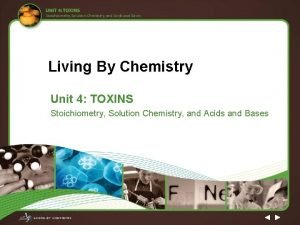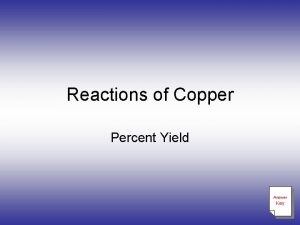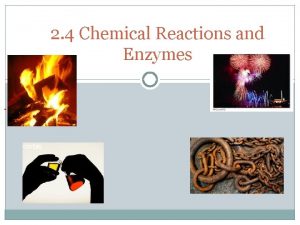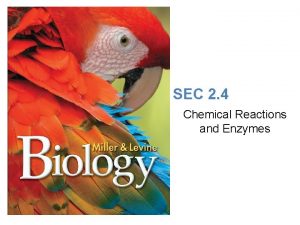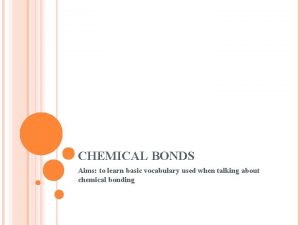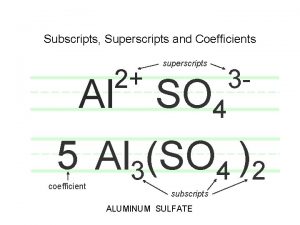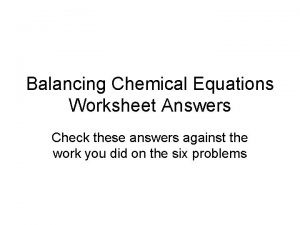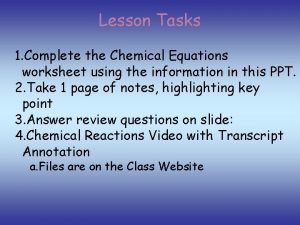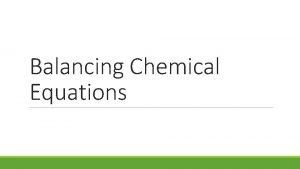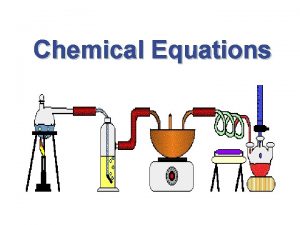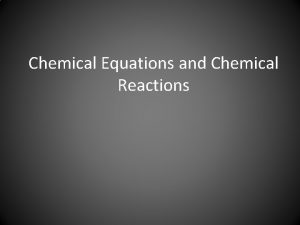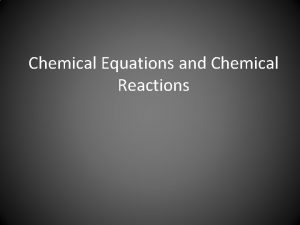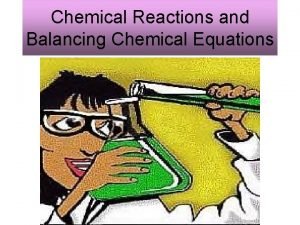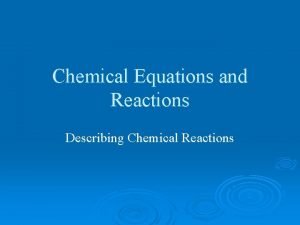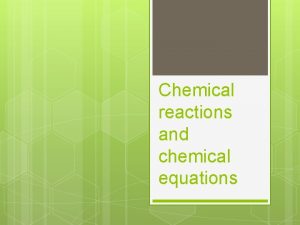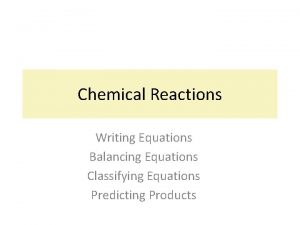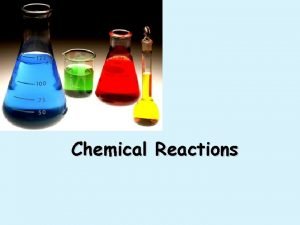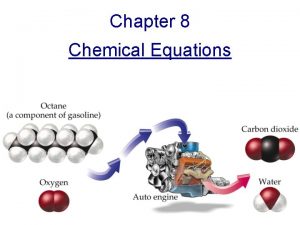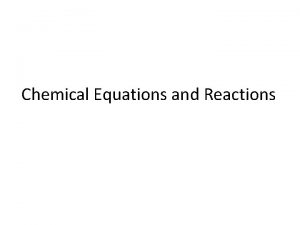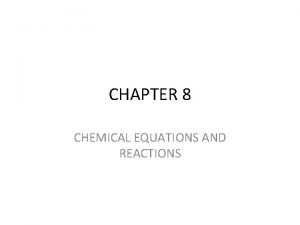CHEMICAL REACTIONS AND EQUATIONS CHEMICAL REACTIONS Chemical Reactions



























- Slides: 27

CHEMICAL REACTIONS AND EQUATIONS

CHEMICAL REACTIONS Chemical Reactions are associated with chemical change. Whenever a chemical change occurs chemical reaction is said to take place Chemical reactions are usually irreversible and a new product is formed. During a chemical Reaction old chemical bonds are broken and new chemical bonds are formed which lead to the formation of new products

Signs of Chemical Reactions There are five main signs that indicate a chemical reaction has taken place: change in color Evolution of a gas Change in temperature Change in state

Word Equations A WORD EQUATION describes chemical change using the names of the reactants and products. Write the word equation for the reaction of methane gas with oxygen gas to form carbon dioxide and water. methane + oxygen Reactant CH 4 + 2 O 2 carbon dioxide + water Product CO 2 + 2 H 2 O

CHEMICAL EQUATIONS The simplest form of description of a chemical reaction in a shorter form is by writing it in the form of an equation. E. g. Mg + O 2 Mg. O It a representation of a chemical change by the help of symbols of elements and formulae of compounds The reactants are written on the left side and product is written on the right side. An arrow is placed between them to show the direction of reaction.

Characteristics Of Chemical Equations The equation must represent the known facts and feasible chemical change � The equation must contain the correct formulae of the reactants and products. � The important conditions of temperature, pressure and catalysts during the reaction must be written on the top of the chemical equation � The law of conservation of mass must be satisfied. �

Showing Phases in a Chemical Equation H 2 O(s) H 2 O(l) H 2 O(g) Solid Phase – the substance is relatively rigid and has a definite volume and shape. Na. Cl(s) Liquid Phase – the substance has a definite volume, but is able to change shape by flowing. H 2 O(l) Gaseous Phase – the substance has no definite volume or shape, and it shows little response to gravity. Cl 2(g)

Balanced Chemical Equations • Chemical equations are of two types- Skeleton Equation and Balanced Chemical Equation. • According to the law of conservation of mass, total mass must be equal on the both sides of the equation. • This type of equation is known as a balanced chemical reaction. E. g. 2 Mg + O 2 2 Mg. O • Here both sides have two atoms of Magnesium and two atoms of Oxygen. Hence the equation is balanced

Unbalanced and Balanced Equations H Cl Cl H H Cl H 2 + Cl 2 HCl (unbalanced) reactants H Cl 2 2 H H Cl Cl Cl H 2 + Cl 2 2 HCl (balanced) reactants products 1 1 Cl H Cl 2 2 products 2 2

CH 4 + 2 O 2 CO 2 + 2 H 2 O Reactants 1 C atom 4 H atoms 4 O atoms Products 1 C atom 4 H atoms 4 O atoms

Visualizing a Chemical Reaction 2 Na 10 mole Na ___ + Cl 2 5 mole Cl 2 ___ 2 Na. Cl 10 ? mole Na. Cl ___

1. Combination reaction A + B AB 2. Decomposition reaction AB A + B 3. Single-displacement reaction 4. Double-displacement reaction 5. Redox reaction A + BC AC + B AB + CD AD + CB

Combination Reactions � The type of reaction in which two reactants combine to form a single product. � E. g. – A + B AB 1. 2. � Ca. O + H 2 O C + O 2 Ca(OH)2 CO 2 They are generally exothermic reactions which involve evolution of heat during reaction.

Combination Reaction 2 Na + Cl 2 Na Cl Cl 2 Na. Cl Na General form: A element or compound + B element or compound AB compound

Decomposition Reaction • The type of reaction in which a single reactant breaks down to give two or more simpler product is called decomposition reaction. • Ex: AB A + B 2 H 2 O 2 H 2 + O 2 • Decomposition reaction can be carried out by the supplying energy by means of heating, electricity or light. It is known as Thermal decomposition, Electrolytic decomposition and Photodecomposition reactions respectively

Decomposition Reaction Decomposition reaction 2 H 2 O 2 H 2 + O 2 H O H + H O H General form: AB compound A + B two or more elements or compounds

Decomposition Reactions Hydrogen Peroxide 2 H 2 O 2 2 H 2 O + 2 H 2 + O 2 Electrolysis of water 2 H 2 O electricity O 2 Nitrogen triiodide 2 NI 3 N 2 + 3 I 2 General Form AB A + B

Displacement Reactions • The reaction in which a more reactive element displaces a less reactive element from its salt solution is known as Displacement Reaction. • This is of two types: 1. Single Displacement Reaction 2. Double Displacement Reaction

SINGLE AND DOUBLE DISPLACEMENT REACTIONS Single-replacement reaction Mg + Cu. SO 4 General form: A + BC Mg. SO 4 AC + + Cu B Double-replacement reaction Ca. CO 3 + General form: AB + 2 HCl Ca. Cl 2 + H 2 CO 3 CD AD + CB

Single Displacement Reaction lead (II) chloride + potassium iodide Pb 2+ Cl 1 Pb Cl 2 + K 1+ I 1 KI potassium chloride + lead (II) iodide Pb 2+ Cl 1 KCl (aq) + K 1+ I 1 - Pb. I 2 (yellow ppt)

Double Displacement Reaction K 2 CO 3 (aq) Potassium carbonate + Ba. Cl 2 (aq) Barium chloride 2 KCl (aq) Potassium chloride + Ba. CO 3 (s) Barium carbonate

Reactivity Series Element Reactivity Ca Foiled again – Aluminum loses to Calcium

Redox Reactions • Redox reactions are those reactions in which both oxidation and reduction takes place simultaneously. • If a substance gains oxygen during a reaction, it is said to be oxidised. If a substance loses oxygen during a reaction, it is said to be reduced • If a substance gains hydrogen during a reaction, it is said to be reduced. If a substance loses hydrogen during a reaction, it is said to be oxidised • Reactions in which this type of change occurs is known as Oxidation and Reduction reactions or Redox reactions. E. g. – Cu. O + H 2 Cu +H 2 O

Redox Reactions • Oxidising agent are those substances which makes available oxygen or removes hydrogen and helps reaction to take place and facilitates the oxidation process. • Reducing agent are those substances which makes available hydrogen or removes oxygen and helps reaction to take place and facilitates the reduction process. • Both oxidising agent and reducing agent facilitates Redox reaction

Oxidation and Reduction Reactions in our daily lives…. There a number of redox reactions which take place in our daily lives. 1. Corrosion 2. Rancidity Corrosion is slow process of self oxidation in which a metal undergoes layer by layer destruction after reaction with atmospheric oxygen and moisture. Ex- Rusting of iron, tarnishing of silver, Copper turns green when exposed in air.

Rancidity. Rancidity is a slow process of self atmospheric oxidation of food containing fats and oils marked with unpleasant smell and taste. Ex. Butter turns rancid Ways to reduce rancity… 1. Storing food in air tight container 2. Storing food low temperature 3. Storing food dark containers to stop reactions by the help of sunlight 4. Use of antioxidants such as BHT ( Butylated Hydroxy Toluene) and BHA (Butylated Hydroxy anisole)

Any Questions… ? THANK YOU BY: NK SINHA
 Section 2 classifying chemical reactions worksheet answers
Section 2 classifying chemical reactions worksheet answers Section 2 reinforcement classifying chemical reactions
Section 2 reinforcement classifying chemical reactions Are kc and kp equal
Are kc and kp equal Chapter 8 review chemical equations and reactions section 2
Chapter 8 review chemical equations and reactions section 2 Chapter 8 section 1 chemical equations and reactions
Chapter 8 section 1 chemical equations and reactions Chapter 8 review chemical equations and reactions
Chapter 8 review chemical equations and reactions I intro
I intro Unit 5 chemical equations and reactions
Unit 5 chemical equations and reactions Types of reactions
Types of reactions Unit 4: toxins lesson 73 worksheet answers
Unit 4: toxins lesson 73 worksheet answers Synthesis reaction
Synthesis reaction Toxic reactions chemical equations
Toxic reactions chemical equations Translating chemical equations
Translating chemical equations Section 1 chemical changes
Section 1 chemical changes Redox half reactions
Redox half reactions Chemistry unit 5 reactions balancing reactions worksheet
Chemistry unit 5 reactions balancing reactions worksheet Chemical reactions reactants and products
Chemical reactions reactants and products Section 2-4 chemical reactions and enzymes
Section 2-4 chemical reactions and enzymes Types of chemical reactions and solution stoichiometry
Types of chemical reactions and solution stoichiometry Types of chemical reactions and solution stoichiometry
Types of chemical reactions and solution stoichiometry Chemical reactions of copper and percent yield report sheet
Chemical reactions of copper and percent yield report sheet Section 2-4 chemical reactions and enzymes
Section 2-4 chemical reactions and enzymes Section 2-4 chemical reactions and enzymes
Section 2-4 chemical reactions and enzymes Building vocabulary: chemical bonds and reactions
Building vocabulary: chemical bonds and reactions Polar to rectangular equation
Polar to rectangular equation Subscript in chemistry
Subscript in chemistry Balancing equations answers
Balancing equations answers Chemical equation worksheet
Chemical equation worksheet











